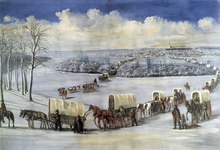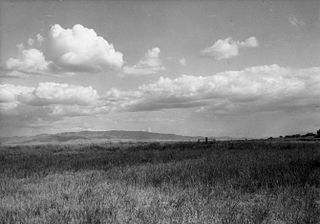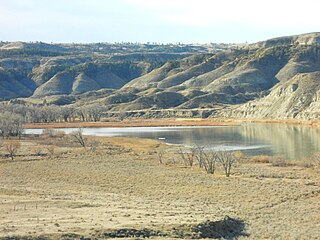

A covered wagon, also called a prairie wagon, whitetop, [1] or prairie schooner, [2] is a horse-drawn or ox-drawn wagon with a canvas top used for transportation or hauling. [3] The covered wagon has become a cultural icon of the American West.


A covered wagon, also called a prairie wagon, whitetop, [1] or prairie schooner, [2] is a horse-drawn or ox-drawn wagon with a canvas top used for transportation or hauling. [3] The covered wagon has become a cultural icon of the American West.
The Conestoga wagon was a heavy American wagon of English and German type from the late 18th century and into the 19th century. It was used for freight and drawn by teams of horses or oxen depending on load. The covered canvas top was supported on eight to twelve angled bows, rather than upright. Capacity was around 4 to 5 tons with no springs. Though it was boat-shaped it did not float. It was used in eastern North America for freight hauling, with some used for southward migration through the Appalachian valleys and along the Great Wagon Road. It was too heavy for use west of the Mississippi River; the westward wagons were lighter, and more angular or square. [4] : 55–56
With roots in the heavy Conestoga wagon developed for the rough, undeveloped roads and paths of the colonial East, the covered wagon spread west with American migration. Typical farm wagons were merely covered for westward expansion and heavily relied upon along such travel routes as the Great Wagon Road, Mormon Trail, Santa Fe Trail, and Oregon Trail, covered wagons carried settlers seeking land, gold, and new futures ever farther west.
Once breached, the moderate terrain and fertile land between the Appalachians and the Mississippi was rapidly settled. In the mid-nineteenth century thousands of Americans took a wide variety of farm wagons [5] across the Great Plains from developed parts of the Midwest to places in the West such as California, Oregon, Utah, Colorado, and Montana. Overland migrants typically fitted any sturdy wagon with several wooden or metal bows which arched high over the bed. Over this was stretched canvas or similar sturdy cloth, creating the distinctive covered wagon silhouette.
For "overlanders" migrating westward, covered wagons were a more common mode of transportation than wheelbarrow, stagecoach, or train. Oxen were the most common draft animal for pulling covered wagons, although mules and horses were also used. Authors of guidebooks written for emigrants noted that oxen were more reliable, less expensive, and nearly as fast as other options. [6]
Prairie schooner is a fanciful name for the covered wagon, drawing on their broad white canvas covers, romantically envisioned as the sails of a ship crossing the sea of prairie grass. [5]
On all the prairie the white-covered wagon was the only sign of human life. It was visible as far as a sail would have been upon the lake, and the prairie, with its graceful undulations that had once been its bottom, waving now with grass, was not unlike the water's surface. A "prairie schooner" was what the settlers called such a wagon.
[A Prairie schooner is an] American emigrant wagon of light/medium weight and dimensions. Headed by a canvas top supported on bow-shaped hoops or tilts. Either sprung or dead axle, up to a capacity of 3 tons. Lever brakes acted on both rear wheels. Drawn by either two or four horses in pole gear. First came to prominence during the gold rush period of the 1840’s. Not to be confused with the much larger Conestoga Wagon.
During the Great Trek starting in 1836, Dutch-speaking settlers in South Africa travelled by wagon trains, migrating northward from British-ruled areas in search of their own homeland. [7] Mostly pulled by pairs of oxen, the Boer trek wagon had a long wheel-base with the sides higher at the rear in typical Dutch fashion. The wagon had a felt or canvas top supported by bowed hoops. [4] : 17

Before railroads in early America, ox-teams and wagons were used to haul overland freight, sometimes in great wagon trains of 10 to 60 teams. Each team of 5 to 7 yoked pairs of oxen pulled two wagons—a lead wagon (averaging 6,500 pounds), which pulled a trailer wagon (4,000 pounds). [8] : 12, 29–30
Military have used covered wagons for transport of supplies. Called "baggage wagons" during the American Revolutionary War, in one account British commander Henry Clinton had a baggage train of 1,500 wagons that stretched 12 miles long. [9] : 192

The Oregon Trail was a 2,170-mile (3,490 km) east–west, large-wheeled wagon route and emigrant trail in the United States that connected the Missouri River to valleys in Oregon Territory. The eastern part of the Oregon Trail spanned part of what is now the state of Kansas and nearly all of what are now the states of Nebraska and Wyoming. The western half of the trail spanned most of the current states of Idaho and Oregon.

A wagon train is a group of wagons traveling together. Before the extensive use of military vehicles, baggage trains followed an army with supplies and ammunition.

A wagon or waggon is a heavy four-wheeled vehicle pulled by draught animals or on occasion by humans, used for transporting goods, commodities, agricultural materials, supplies and sometimes people.

Kittanning Gap, one of the gaps of the Allegheny, is a now a relatively unimportant wooded ravine along the ascent of the Allegheny Ridge (also called the 'Allegheny Front' or 'Allegheny escarpment') in central Pennsylvania in the United States. The gap was one of several optional paths of the Kittanning Path Amerindian trail turned into an emigrant route over the Alleghenies in the day of animal powered technology. The option up the gap was likely the 'better choice' of an ascending route for ox cart and wagon encumbered white settlers pouring west across the Alleghenies escarpment.

Fort Hall was a fort in the Western United States that was built in 1834 as a fur trading post by Nathaniel Jarvis Wyeth. It was located on the Snake River in the eastern Oregon Country, now part of present-day Bannock County in southeastern Idaho. Wyeth was an inventor and businessman from Boston, Massachusetts, who also founded a post at Fort William, in present-day Portland, Oregon, as part of a plan for a new trading and fisheries company. In 1837, unable to compete with the powerful British Hudson's Bay Company, based at Fort Vancouver, Wyeth sold both posts to it. Great Britain and the United States both operated in the Oregon Country in these years.

The California Trail was an emigrant trail of about 1,600 mi (2,600 km) across the western half of the North American continent from Missouri River towns to what is now the state of California. After it was established, the first half of the California Trail followed the same corridor of networked river valley trails as the Oregon Trail and the Mormon Trail, namely the valleys of the Platte, North Platte, and Sweetwater rivers to Wyoming. The trail has several splits and cutoffs for alternative routes around major landforms and to different destinations, with a combined length of over 5,000 mi (8,000 km).

The Conestoga wagon is a specific design of heavy covered wagon that was used extensively during the late eighteenth century and the nineteenth century in the eastern United States and Canada. It was large enough to transport loads up to six short tons, and was drawn by horses, mules, or oxen. It was designed to help keep its contents from moving about when in motion and to aid it in crossing rivers and streams, though it sometimes leaked unless caulked.

A chuckwagon or chuck wagon is a horse-drawn wagon operating as a mobile field kitchen and frequently covered with a white tarp. Also called a camp wagon or round-up wagon. It was historically used for the storage and transportation of food and cooking equipment on the prairies of the United States and Canada. They were included in wagon trains for settlers and traveling workers such as cowboys or loggers. In modern times, chuckwagons feature in special cooking competitions and events. Chuckwagons are also used in a type of competition known as chuckwagon racing.

Fort Kearny was a historic outpost of the United States Army founded in 1848 in the western U.S. during the middle and late 19th century. The fort was named after Col. and later General Stephen Watts Kearny. The outpost was located along the Oregon Trail near Kearney, Nebraska. The town of Kearney took its name from the fort. The "e" was added to Kearny by postmen who consistently misspelled the town name. A portion of the original site is preserved as Fort Kearny State Historical Park by the Nebraska Game and Parks Commission.

The Bozeman Trail was an overland route in the Western United States, connecting the gold rush territory of southern Montana to the Oregon Trail in eastern Wyoming. Its most important period was from 1863 to 1868. Despite the fact that the major part of the route in Wyoming used by all Bozeman Trail travelers in 1864 was pioneered by Allen Hurlbut, it was named after John Bozeman. Many miles of the Bozeman Trail in present Montana followed the tracks of Bridger Trail, opened by Jim Bridger in 1864.

The Big Trail is a 1930 American pre-Code Western early widescreen film shot on location across the American West starring 23-year-old John Wayne in his first leading role and directed by Raoul Walsh. It is the final completed film to feature Tyrone Power Sr. before his death in 1931, as well as his only sound role.
Meek Cutoff was a horse trail road that branched off the Oregon Trail in northeastern Oregon and was used as an alternate emigrant route to the Willamette Valley in the mid-19th century. The road was named for frontiersman Stephen Meek, who was hired to lead the first wagon train along it in 1845. The journey was a particularly hard one, and many of the pioneers lost their lives.

An oxOKS, also known as a bullock, is a bovine, trained and used as a draft animal. Oxen are commonly castrated adult male cattle; castration inhibits testosterone and aggression, which makes the males docile and safer to work with. Cows or bulls may also be used in some areas.

A horse-drawn vehicle is a piece of equipment pulled by one or more horses. These vehicles typically have two or four wheels and were used to carry passengers or a load. They were once common worldwide, but they have mostly been replaced by automobiles and other forms of self-propelled transport but are still in use today.

An ox-wagon or bullock wagon is a four-wheeled vehicle pulled by oxen. It was a traditional form of transport, especially in Southern Africa but also in New Zealand and Australia. Ox-wagons were also used in the United States. The first recorded use of an ox-wagon was around 1670, but they continue to be used in some areas up to modern times.

A wagon fort, wagon fortress, wagenburg or corral, often referred to as circling the wagons, is a temporary fortification made of wagons arranged into a rectangle, circle, or other shape and possibly joined with each other to produce an improvised military camp. It is also known as a laager, especially in historical African contexts, and a tabor among the Cossacks.

The Montana Trail was a wagon road that served gold rush towns such as Bannack, Virginia City and later Helena during the Montana gold rush era of the 1860s and 1870s. Miners and settlers all traveled the trail to try to find better lives in Montana. The trail was also utilized for freighting and shipping supplies and food goods to Montana from Utah. American Indians, as well as the weather, were major risks to traveling on the Montana Trail.
In the history of the American frontier, pioneers built overland trails throughout the 19th century, especially between 1829 and 1870, as an alternative to sea and railroad transport. These immigrants began to settle much of North America west of the Great Plains as part of the mass overland migrations of the mid-19th century. Settlers emigrating from the eastern United States did so with various motives, among them religious persecution and economic incentives, to move from their homes to destinations further west via routes such as the Oregon, California, and Mormon Trails. After the end of the Mexican–American War in 1849, vast new American conquests again encouraged mass immigration. Legislation like the Donation Land Claim Act and significant events like the California Gold Rush further encouraged settlers to travel overland to the west.

Cow Island lies in a left turning bend of the Missouri River, in the area known as the Missouri River Breaks. The island is formed by sediments that are seasonally washed out from the mouths of Cow Creek and Bull Creek, which enter the Missouri River just upstream from Cow Island. The island is about 1.2 miles long and averages about 150 yards in width. It is located in extreme northern Fergus County, but lies across the river from extreme southern Blaine County, to its east.
Windwagon Smith is an American tall tale about a sea captain who traveled in a Conestoga wagon, fitted with a sail, across the Kansas prairie. The tale was the subject of a 1961 animated Walt Disney Pictures film, The Saga of Windwagon Smith.
As far as the eye reached, white-top wagons, drawn each by six handsomely harnessed mules, trailed along the narrow road. As the way pushed up the mountain, far away, the white-tops slowly ascended with it.
With a captain elected by popular vote, the wagon train pulled away from civilization. At night the lumbering whitetops were drawn into a circle, a night herder grazed the oxen on nearby hills and each emigrant started his cooking fire by the side of his wagon.
Trains of from twenty to sixty wagons were observed heading out over the prairie […] watching a fleet of whitetops undulate across the prairie slopes.
Oh, the white-tops are a-rollin', rollin', the big wheels keep on turnin' ('Song of the Wagonmaster').
A 'prairie schooner' was what the settlers called such a wagon.